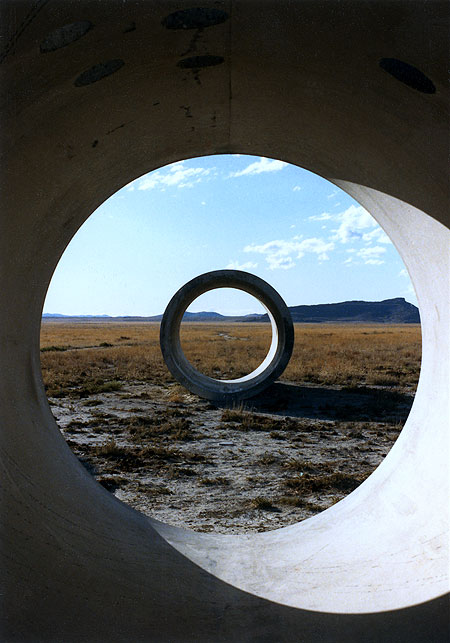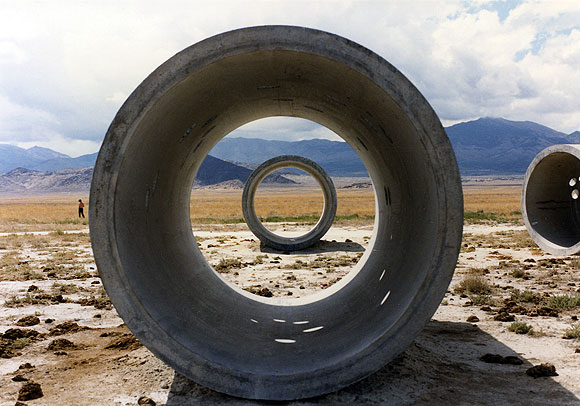
Tyler Green of Modern Art Notes recently reported on his trip to Sun Tunnels, Nancy Holt's earthwork in northern Utah. Sounds like he had a so-so time. Green thinks the work hasn't aged well, and I can't comment on that but am posting these snapshots from a trip my brother and I took there in the '80s, to show the magic Holt's piece is (or was) capable of. I'd be surprised if you couldn't get similar views now, but here's what Green says: "They never came to life, they never became exciting. They seemed too self-consciously monumental, too interested in being pagan totems to artisanal existence. Sun Tunnels is too much a post-industrial Stonehenge-like gesture to succeed as an engaging artwork. While the greatest pieces of land art exist within nature and bring their environment into the artwork--think how the Jetty and the Great Salt Lake co-exist or how Lightning Field is placed within its space--Sun Tunnels rejects its own landscape. Each tunnel looks like it had started to erode (Sun Tunnels was built in 1976) and was later patched so as to maintain its shape. While the Jetty basks in its location, Sun Tunnels seems to fight its off. The Tunnels' roundness is just too jarring, too inappropriate for this landscape. Sun Tunnels is funky cool in an I-was-there kind of way. But that's as far as they get."


Turning to my pics from the '80s, that's me in the middle photo, wearing my high desert button-down shirt, with my brother holding the camera. That's him off in the distance in the third shot. The bottom pic also shows some unfortunate cow pies around the piece at that time. I wrote Holt a letter after our visit and she wasn't too happy to hear about the cattle, but said that unless she fenced the area there was no guarantee the livestock would stay out. In the middle photo, you can see ricochet marks of bullets fired off by local art lovers inside the tubes. ("It blowed up good." "It blowed up real good.") Small wonder Holt has to keep them patched.
Some earthworks, notably Michael Heizer's, are jarring interventions in the landscape, and I'm really not sure what Green means when he says Sun Tunnels fails to "bring the environment within the artwork." Holt positioned the tunnels on the desert flatness so that one sees a different, exquisite mountain vista from each of the four possible vantage points. These distant geologic bulges are framed within the near-mystical concentric circles that appear when you view the tunnels head on--the top photo conveys some of the Magrittean effect. The choice of where to place them wasn't arbitrarily aesthetic, though: the cylinders are aligned with the positions where the sun rises and sets at the solstices (hence the piece's name). She cut smaller rounded holes in the tunnel walls, corresponding to the shapes of stellar constellations, which cast circles of sunlight or moonlight within the darkened tubes. Much like the work of Holt's husband Robert Smithson (this was her first piece after his death, I believe) Sun Tunnels combines analytical modernism--a costly desert construction project the purpose of which is to optically slice and contain the landscape--and pre-scientific, ritual channeling of light from heavenly bodies. Green's phrase "post-industrial Stonehenge" captures the essence but not the excitement. We spent about fourteen hours at the tunnel site, and watched the landscape (and skyscapes) change from afternoon to dusk to darkest night, leaving about 3 am to catch an early morning flight from Salt Lake City. The experience was rich and unforgettable.
I heard Holt speak in the mid-80's. I found her ideas to be strangly aligned to the philosophies of the new-age movement's less interesting spokespeople at the time. How could Smithson, the Lou Reed of the Art World, have stood that hippy stuff?
I think Smithson was more interested in mysticism (a la Native American) than Lou. Spiral Jetty is a big whirlpool-omphalos-cosmic force vector, etc.--besides being a material thing. Holt may have needed his skepticism to keep the new age stuff in balance.
Good point. Smithson's work can be looked at as a sort of meditation on or intended form of shamanism.
My photo compared to Pink Floyd cover, plus other discussion, here.
|
Tyler Green of Modern Art Notes recently reported on his trip to Sun Tunnels, Nancy Holt's earthwork in northern Utah. Sounds like he had a so-so time. Green thinks the work hasn't aged well, and I can't comment on that but am posting these snapshots from a trip my brother and I took there in the '80s, to show the magic Holt's piece is (or was) capable of. I'd be surprised if you couldn't get similar views now, but here's what Green says: "They never came to life, they never became exciting. They seemed too self-consciously monumental, too interested in being pagan totems to artisanal existence. Sun Tunnels is too much a post-industrial Stonehenge-like gesture to succeed as an engaging artwork. While the greatest pieces of land art exist within nature and bring their environment into the artwork--think how the Jetty and the Great Salt Lake co-exist or how Lightning Field is placed within its space--Sun Tunnels rejects its own landscape. Each tunnel looks like it had started to erode (Sun Tunnels was built in 1976) and was later patched so as to maintain its shape. While the Jetty basks in its location, Sun Tunnels seems to fight its off. The Tunnels' roundness is just too jarring, too inappropriate for this landscape. Sun Tunnels is funky cool in an I-was-there kind of way. But that's as far as they get."
Turning to my pics from the '80s, that's me in the middle photo, wearing my high desert button-down shirt, with my brother holding the camera. That's him off in the distance in the third shot. The bottom pic also shows some unfortunate cow pies around the piece at that time. I wrote Holt a letter after our visit and she wasn't too happy to hear about the cattle, but said that unless she fenced the area there was no guarantee the livestock would stay out. In the middle photo, you can see ricochet marks of bullets fired off by local art lovers inside the tubes. ("It blowed up good." "It blowed up real good.") Small wonder Holt has to keep them patched.
Some earthworks, notably Michael Heizer's, are jarring interventions in the landscape, and I'm really not sure what Green means when he says Sun Tunnels fails to "bring the environment within the artwork." Holt positioned the tunnels on the desert flatness so that one sees a different, exquisite mountain vista from each of the four possible vantage points. These distant geologic bulges are framed within the near-mystical concentric circles that appear when you view the tunnels head on--the top photo conveys some of the Magrittean effect. The choice of where to place them wasn't arbitrarily aesthetic, though: the cylinders are aligned with the positions where the sun rises and sets at the solstices (hence the piece's name). She cut smaller rounded holes in the tunnel walls, corresponding to the shapes of stellar constellations, which cast circles of sunlight or moonlight within the darkened tubes. Much like the work of Holt's husband Robert Smithson (this was her first piece after his death, I believe) Sun Tunnels combines analytical modernism--a costly desert construction project the purpose of which is to optically slice and contain the landscape--and pre-scientific, ritual channeling of light from heavenly bodies. Green's phrase "post-industrial Stonehenge" captures the essence but not the excitement. We spent about fourteen hours at the tunnel site, and watched the landscape (and skyscapes) change from afternoon to dusk to darkest night, leaving about 3 am to catch an early morning flight from Salt Lake City. The experience was rich and unforgettable.
- tom moody 9-24-2006 12:42 am
I heard Holt speak in the mid-80's. I found her ideas to be strangly aligned to the philosophies of the new-age movement's less interesting spokespeople at the time. How could Smithson, the Lou Reed of the Art World, have stood that hippy stuff?
- steve 9-24-2006 8:27 am
I think Smithson was more interested in mysticism (a la Native American) than Lou. Spiral Jetty is a big whirlpool-omphalos-cosmic force vector, etc.--besides being a material thing. Holt may have needed his skepticism to keep the new age stuff in balance.
- tom moody 9-24-2006 8:53 am
Good point. Smithson's work can be looked at as a sort of meditation on or intended form of shamanism.
- steve 9-24-2006 9:07 am
My photo compared to Pink Floyd cover, plus other discussion, here.
- tom moody 9-25-2006 7:48 pm